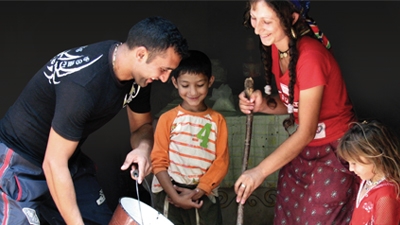If you are a Roma child living in Romania today, the likelihood that you were born into poverty is three times higher than other Romanians born around you. You will likely grow up in an overcrowded dwelling or a slum, will probably not finish school, and you are not likely to find a job. Your life expectancy is at least six years less than your non-Roma peers.
This understanding of inequality beginning at birth and continuing through every stage of life for the majority of Roma living in Romania today is the cornerstone of the shared prosperity agenda in the country – pointing to the need to develop programs, policies, and initiatives that take a more comprehensive approach toward social inclusion for Roma.
In addressing this need, the Ministry of Labor, Social Protection and the Elderly has worked with the World Bank Group - using a Reimbursable Advisory Services (RAS) - to produce a report that utilizes an integrated, “life cycle” approach to address the different social and economic barriers that most Roma face throughout their entire lives. By taking a broader look at exclusion, the Diagnostics and Policy Advice for Supporting Roma Inclusion in Romania study examines the social and economic barriers most Roma face throughout their entire lives.
“Roma exclusion is perpetuated over generations,” says Kosuke Anan, a Social Development Specialist at the World Bank, and co-author of the report. “For example,” he continues, “inadequate education and skills and poor health hamper one’s access to earning opportunities. At the same time, the lack of earning opportunities results in insufficient resources to support children’s continued education and to maintain living conditions conducive to good health. That is why we think this ‘life cycle’ approach can affect real change.”
For many Roma, discrimination and exclusion are interwoven into different elements of their daily existence and persist throughout their entire lives. For example, the socio-economic conditions in which Roma grow up and live expose them to greater risk to their health in comparison with their non-Roma neighbors. Health problems that often result from poor health and nutrition in early childhood are exacerbated by a lack of access to healthcare and treatment later in life. Further complicating these health issues, according to the report, is the fact that 42% of Romanian Roma do not seek health care when they actually need it because they cannot afford the care – leading to increased health problems and early death.
Roma will also likely face employment difficulties, born from limited access to education and training. Inequalities start early in life, with enrollment in preschool among Roma in the country being only 37%, compared to 63% for non-Roma children living in the same neighborhood. By the age of 16 only 29% of Roma men and 18% of Roma women are still in school – contributing to an employment rate that is just 42% for men and 19%for women.
Labor market exclusion will continue among future generations of Roma unless the inequality of opportunity is addressed. The inequalities start early in life and continue in preschool and through compulsory and upper-secondary education. This vicious cycle is not only detrimental to the health and livelihoods of Roma in Romania, it also hampers the robustness of the country’s economy as a whole. With an ageing population and a young and growing Roma minority, Romania cannot afford to leave Roma children, youth, or their families behind.
Put simply: Roma inclusion is not just the right thing to do, it is smart economics.
Survey data indicate that just over 37% of the Romanian Roma population is under the age of 15 – a sharp contrast to the rest of Romania, which faces demographic challenges as its population gets older. Social inclusion of Roma is critical in helping the country face this challenge and is a key element to unlocking some of the country’s untapped economic potential: it is estimated that equalizing labor market earnings in Romania for Roma could result in potential annual economic benefits that range between €887 million and €2.9 billion annually.
In order to unlock this potential, it is necessary to promote Roma inclusion that is based on a comprehensive understanding of the interconnected dimensions of exclusion. By taking a more complete look at the various and complementary socio-economic factors that prevent Roma from receiving adequate health care, completing their education, and integrating into the labor market, this latest report aims toward designing targeted interventions and institutional mechanisms capable of affecting positive change across a variety of intersecting dimensions.
Adequate development for Roma children in the first 1000 days of life, improving the access and quality of education, preventing school dropouts of Roma pupils, investing in skills development for Roma out of the education system, improving living conditions and combating discrimination and negative stereotypes are all included within the goals and recommendations of this report – along with many others. To make this possible, the report suggests clarifying institutional responsibilities, grounding strategies in expected results and budgets, strengthening monitoring and evaluation of Roma inclusion policies and programs, and targeting and supporting disadvantaged communities at the local level.
"Early childhood development will determine a child's prospects and opportunities for the rest of her life," says Sandor Karacsony, a Human Development Economist at the World Bank and co-author of the study, "the proposed life-cycle approach aims at providing equal opportunities for the next generation of Roma and, at the same time, boosting the wellbeing of their families."
By recognizing the multipronged nature of the social inclusion agenda and by adjusting its development agenda accordingly, the country gets one step closer to ensuring that the next child born into a Roma family will have equal access to adequate health care, education, and employment opportunities –boosting shared prosperity for all people in the country.

